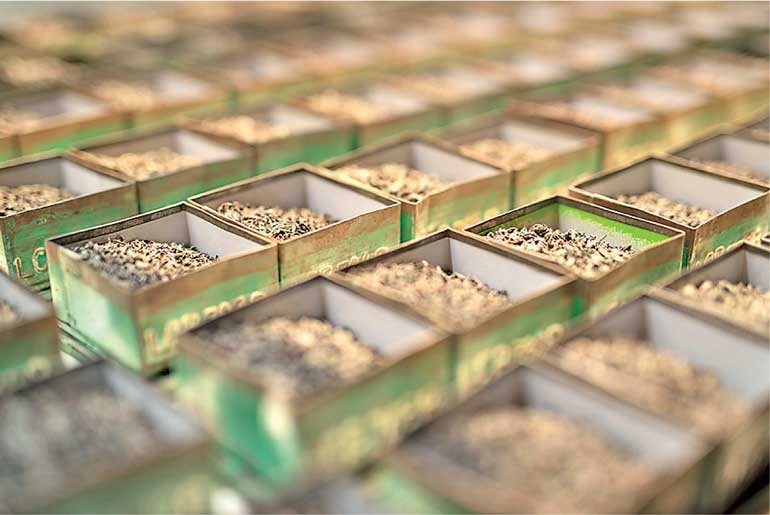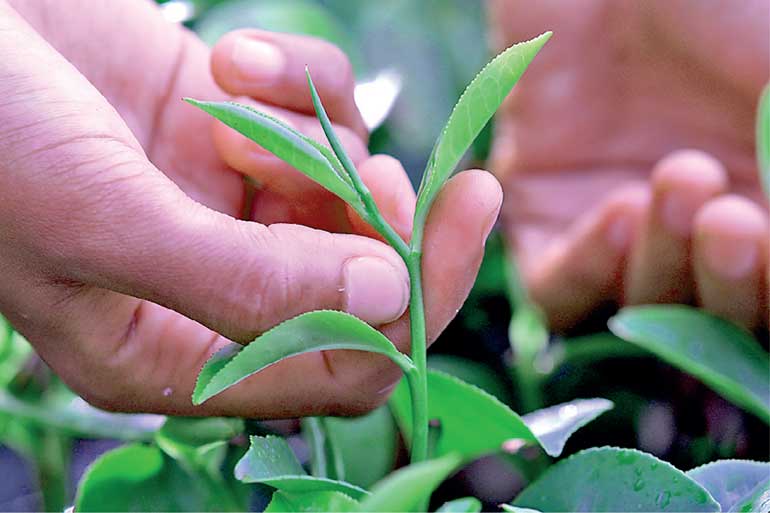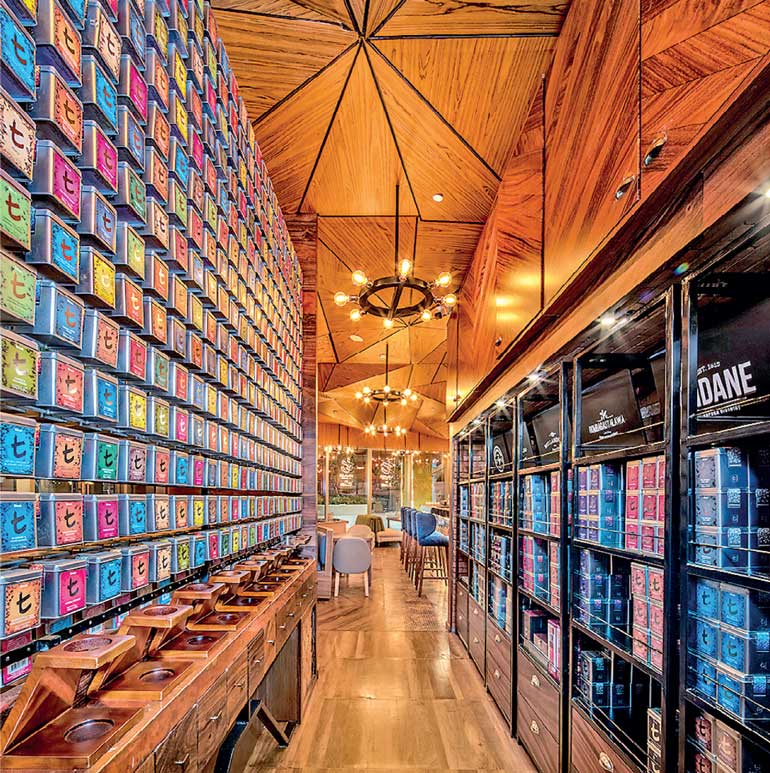Sunday Apr 20, 2025
Sunday Apr 20, 2025
Friday, 29 October 2021 00:00 - - {{hitsCtrl.values.hits}}

We taste 10,000 teas each week, an alluring variety of aromas, flavours and textures in tea. Taste, goodness and indulgence with purpose – the new luxury

Handpicking just the two leaves and the bud

The t-Lounge by Dilmah is an upscale, elegant place designed around the enjoyment and appreciation of fine tea
By Dilhan C. Fernando
A new generation is driving change in a tea category where for decades price has meant more than taste or goodness. The trend they are forcing is about taste and wellness but so much more. As younger customers turn to tea, they are demanding a more sincere appreciation of ethics and sustainability. This offers a glimmer of hope for passionate tea growers who make tea for the love of the leaf.
tea, they are demanding a more sincere appreciation of ethics and sustainability. This offers a glimmer of hope for passionate tea growers who make tea for the love of the leaf.
Predicting trends in tea was a lot easier a few years ago. There wasn’t much choice – black tea – with or without milk, Earl Grey or lemon, green tea, and maybe a couple of herbs like chamomile and peppermint. Fortunately that’s history now. Accelerated by an explosion in gastronomy, tea drinkers’ tastes for adventure brought Oolongs, artisanal teas and a multitude of herbs – not really tea, but tisanes – into the picture. Then came the pandemic and the volatility the world experienced seeped into our brewing habits.
Mindfulness the new norm
A single word that sums up the change – mindfulness. In the new norm, tea drinkers are more mindful than ever of the goodness in what they eat and drink. Tea has an abundance of the good stuff. Good quality black, green, oolong and white tea naturally have uniquely high flavonoid content. Flavonoids are antioxidants that can protect our bodies from oxidative stress – a key factor in the development of heart disease, stroke, cancer, diabetes, dementia and other non-communicable diseases. Antioxidants in tea are also said to boost immunity and help the body cope with emotional stress. Who wouldn’t want a mugful of all that?
That’s not all consumers are becoming mindful of; with the new normal fraught with climate anxiety and greater awareness of social and economic inequality, consumers want – more than ever – to drink what is good for others too. That’s great, but also a little ironic because it was in the name of making product affordable for consumers that retailers and monopolistic brands around the world forced the race to the bottom in pricing and promotions, creating the human and environmental consequences we see in most producing countries today.
A matter of choice
There lies another complication to predicting what might be in 2022 and beyond, because no matter what consumers desire, the products they consume are still determined significantly by the choice they have in their local store. And that is decided by which major brands dominate that space, which quality brands can afford both good quality (i.e. more expensive) tea and the phenomenally expensive real estate known as the supermarket shelf.
The answer to that is, not many. The internet helps deliver choice and in spite of the dominant e-tailers and their similarly expensive promotional demands, we have hope of a more equitable marketplace one day.
For us there is only one way to make good tea. It involves picking leaves and bud by hand, making tea according to an artisanal tradition in a sustainable relationship with nature, and by workers who are paid a fair wage. As with any ethical endeavour, profits must be shared with the less fortunate. The formula is logical and, for a family tea company, non-negotiable.
For an industry with a harsh colonial history, and a hostile environment defined by discount culture, it is more complicated. Yet the good stuff in tea is where there is change for the better.
Taste adventure
Tea and mindfulness align elegantly, so which teas can we expect to see in future? That’s one area where there is definitely a long tail, with taste adventure in tea wonderfully fragmented into a multiplicity of personal preferences, brewing methods, garnishes, recipes, pairings and cultural preferences. There is no other beverage that can equal tea when it comes to the myriad hues, aromas, flavours, textures and their agreeable synergy with food.
Non-alcoholic drinks are trending, but without compromise on theatre and taste. Every speciality loose leaf tea fulfils that requirement, adding the allure of aroma, flavour and texture crafted by none other than Nature herself.
Also trending is escapism, drinkers seeking to get away from the harshness of the present, even for a moment. That points to chai … a delicious, comforting, profusion of strong tea with dairy, almond or oat milk, with mint, pepper, chili, star anise or other spices, herbs and roots, and even a dash of alcohol, like my favourite Saturday afternoon indulgence, Dilmah Pirate’s Chai (with Rum).
Chai can be personalised to every individual taste, culture, moment and ingredient preference because there is no perfect chai, only a multitude of tastes which tell the chai puller’s personal story. Have a look at our ‘Book of Chai’ for a few hints.
Authenticity
Tea in 2022 and beyond is also likely to pivot around authenticity. Like antioxidants, that’s a feature that real tea offers in plenty. The traditional method of making tea is based on respect for nature – handpicking the most tender leaves, where flavour and natural antioxidants are highest, withering the leaf to concentrate both, rolling in a manner that mimics what physicians did 5,000 years ago as they made tea, then as a medicine. Finally fermenting (black and oolong tea) and then firing or drying.
With the tea plant, camellia sinensis, so dramatically shaped by a confluence of natural factors like wind, sunshine, rain, humidity and soil, that method of manufacture nurtures in each batch of tea a very specific expression of nature – its terroir.
There is no single tea that represents this particular allure in tea, but a thousand different teas, which vary over time, and are as changeable as the weather that influences flavour, aroma, texture and appearance in tea. It extends over black tea, from light to intense, through oolongs dark and light, green teas from floral to slightly bitter and white teas from aromatic to delicate.
A social herb
Mindfulness aside, tea has always been a very social herb. With its imperial roots in China, its royal debut in Europe, the etiquette, poetry and parties that characterised its evolution, tea has always invoked conversation and relationships.
There is now scientific research to back up the assertion of ancient poets who referred to the ability of tea to inspire and uplift mood and mental state. This adds to the role and function of tea in the 21st Century, when unprecedented escalation of mental health concerns demand kindness. There is simple, affordable impact in shared mugs of tea with friends, family or strangers for whom a moment of friendship could be much more significant than what it may seem.
Fine tea to the fore
There will certainly be a greater appreciation of the taste, goodness and purpose in fine and perfectly brewed tea. Even with the faintly ridiculous tea brewing methods that are being touted as the perfect method by a throng of internet experts in tea, the appreciation of the finest teas will grow alongside the appreciation of authenticity and love for produce, because fine tea can only be produced with love. The aged, mixed, unloved and heavily discounted stuff will continue to sell and delight marketers though only until they win their race to the bottom in discounting and find that it is time to sell their brands.
The dreams of many passionate tea growers have unjustly met their demise in a market where the short-term pleasure of discount outweighed the long-term benefit of quality. Growers who produce teas with love, were previously exploited by a colonial economic system, but not a lot has changed with a universally detrimental discount culture taking its place.
That is changing though – hopefully – as enlightened, empowered and empathetic consumers seek change – better quality teas for themselves and better lives for the people that make the produce they consume. This will gladden the hearts of tea growers because the indulgence, variety, purity, authenticity and provenance in fine tea is without parallel and it is a joy that too few have experienced.
That prediction is likely to evolve as 21st century tea drinkers realise the inspiring synergy that exists between tea and food with the right tea having the ability to enhance flavour, texture, mouthfeel and then … wait for it ... aid digestion, helping the body manage sugars, excrete fats and finally cleanse the palate.
Tea is a very special herb – devoid of ethnic, religious or cultural barrier, imbued with taste defined by nature and the promise of goodness and friendship. The true test of the adventure that is an emerging trend in tea, will not be limited to taste, but also in broader consciousness of ethics and sustainability in tea.
Fair prices
With the realisation that the unceasing discounts come at the cost of fair wages, quality and sustainability, must come fair prices because that is the natural beginning and end for genuinely fair trade. That alone will be sufficient to brew up a wonderful combination of variety, authenticity and innovation led by the passionate producers who were the reason tea became a global phenomenon.
That is the most promising trend for tea, fair prices leading to genuine social and environmental sustainability, enabling producers to devote themselves to producing beautiful teas, with kindness to nature and community.
That’s a combination of taste and mindfulness that tea drinkers and tea growers can celebrate together.
(Dilhan C. Fernando is the younger son of Dilmah Founder Merrill J. Fernando. A graduate of the London School of Economics and currently CEO of Dilmah Tea, as Trustee of the Merrill J. Fernando Foundation, and Director of Dilmah Conservation he directs the fulfilment of his father's unique commitment to serving humanity and environment through business. Dilhan serves as Chair of UN Global Compact Network Sri Lanka and Biodiversity Sri Lanka, a pioneering environmental collaboration amongst the Ceylon Chamber of Commerce, IUCN and Dilmah Conservation.)
Discover Kapruka, the leading online shopping platform in Sri Lanka, where you can conveniently send Gifts and Flowers to your loved ones for any event including Valentine ’s Day. Explore a wide range of popular Shopping Categories on Kapruka, including Toys, Groceries, Electronics, Birthday Cakes, Fruits, Chocolates, Flower Bouquets, Clothing, Watches, Lingerie, Gift Sets and Jewellery. Also if you’re interested in selling with Kapruka, Partner Central by Kapruka is the best solution to start with. Moreover, through Kapruka Global Shop, you can also enjoy the convenience of purchasing products from renowned platforms like Amazon and eBay and have them delivered to Sri Lanka.
Discover Kapruka, the leading online shopping platform in Sri Lanka, where you can conveniently send Gifts and Flowers to your loved ones for any event including Valentine ’s Day. Explore a wide range of popular Shopping Categories on Kapruka, including Toys, Groceries, Electronics, Birthday Cakes, Fruits, Chocolates, Flower Bouquets, Clothing, Watches, Lingerie, Gift Sets and Jewellery. Also if you’re interested in selling with Kapruka, Partner Central by Kapruka is the best solution to start with. Moreover, through Kapruka Global Shop, you can also enjoy the convenience of purchasing products from renowned platforms like Amazon and eBay and have them delivered to Sri Lanka.